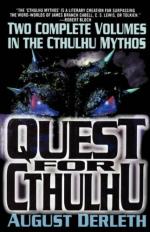|
This section contains 345 words (approx. 2 pages at 300 words per page) |

|
Derleth's depiction of external and internal evil accords well with Christian teachings and is unlikely to cause fear and trembling to any but a reader already deranged.
The story offers mystery more than dread, and its fantasy world is more fun than frightening. This fantasy realm also harbors pagan and non-Christian elements. The success of H. P. Lovecraft's stories that began the Cthulhu Mythos, expanded on by Derleth and others, depends in part on animistic religious beliefs, spiritual perceptions practiced in some form by most past cultures at some point in their development. Animism holds that natural phenomena such as the wind or fire—as well as animals, plants, and inanimate objects— may have spirits, and it also posits that the universe has many free floating spirits that can sometimes be accessed by human beings. Humans are insignificant in animistic beliefs, about as important...
|
This section contains 345 words (approx. 2 pages at 300 words per page) |

|




